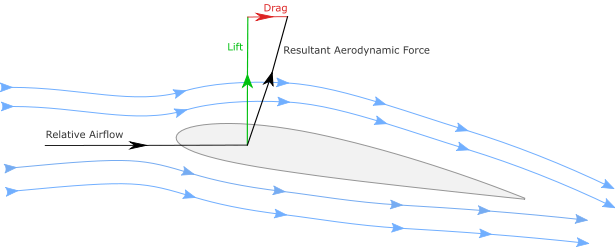Lift
|
⚠
|
This is a developing content and needs to be reviewed. Help Swyde by improving the content and participating in the discussions.
|
Contents
Explanationedit
Lift is a mechanical force induced on an airfoil of an aircraft when the body moves through the air. The incoming stream of air, when it encounters the wings, it flows through the contour of both the surfaces and then at the trailing edge, gets turned downwards due to the shape and angle of the wing. As the wing exerts a force on the air to influence its inertia, an equal amount of force is applied by the stream of air onto the wing in the opposite direction. The resultant aerodynamic force gets resolved into two components. The vertical component that lifts the airplane, countering the weight is called as the lift and the horizontal component that opposes the forward motion of the aircraft is called as drag.
Frequently Asked Questionsedit
How lift is generated?edit
In aerodynamics, lift is generated when a streamlined object like an airfoil or a thin plate moves through the air at a certain angle. This can be understood with newton’s third law of motion and Bernoulli’s principle. When the airflow encounters the leading edge of the wing, the flow gets separated into upstream and downstream and then is turned downward due to the shape of the airfoil. This interaction itself produces an equal amount of aerodynamic force on the wing, which gets resolved as lift and drag as discussed in the explanation section. Further down, the air that moves on the top side of the wing is faster than that of the airflow on the bottom side.
According to Bernoulli’s principle, this variation in velocities on either surface of the wings create a pressure difference that results in an aerodynamic force. Due to the shape of the airfoil, the lift component is higher than the drag component. But the primary contribution to the lift is due to the characteristic effect of the third law of motion.
How lift is generated when the airplane is upside down?edit
In most airplanes that are capable of flying inverted, the airfoil would be a symmetrical airfoil that is capable of producing lift in that position. So in an inverted airplane with a symmetrical airfoil, when the pilot pushes the control stick the angle of attack would decrease and produce a negative lift relative to the normal orientation of the plane, but in reality, it would be creating a positive lift as it is flying inverted.
What causes the upwash in the leading edge of the airfoil?edit
When the free stream air encounters the wing, the air flow slows down due to the obstruction of the wing. Thus the airflow is brought almost to rest near an arbitrary point at the leading edge of the wing (a point for 2-dimensional airfoil, a line for a 3-dimensional wing). This point is technically called as the stagnation point. Now the airflow that approaches this point would either go upwards or downwards. Why? Because of the fact that the air stream just above the skin of the wing on the upper surface has a very low pressure compared to that of the air streams above it that gradually reaches atmoshperic pressure. So these high velocity air molecules near the skin sort of creates low-pressure 'sink' for the high-pressure air upstream (the air around the stagnation region). This accelerates the streamline towards the trailing edge. Back at the stagnation region, the rest of the upstream air, due to the dynamic equilibrium, air flows below the wings.
What causes the downwash in the trailing edge of the airfoil?edit
The low-pressure air accelerated through out the contour of the upper surface of the airfoil, due to inertia, tends to follow the contour unless acted on by other forces. When the contour ends at the trailing edge, the air gets mixed up by the high pressure air from the bottom surface and the air stream at atmospheric pressure above it, everything tends to attain an equilibrium. The net effect of this equilibrium is that the total momentum of all the air molecules goes downward (and sideways for a 3D wing) due to the pressure difference in the upper and lower regions.

